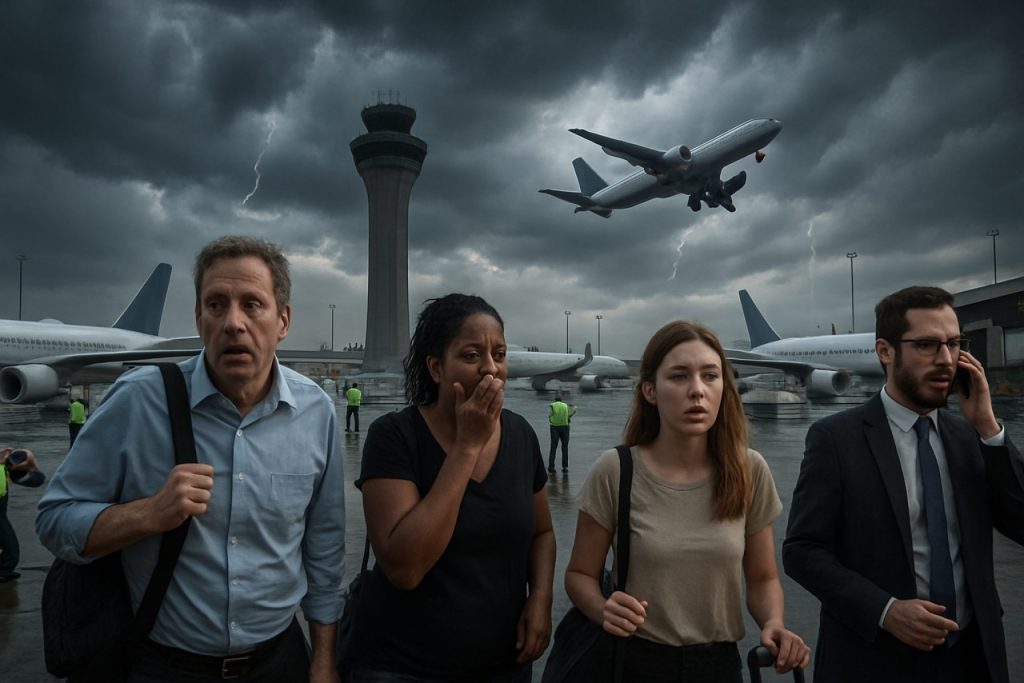
- Multiple loss-of-communication incidents at major airports, including Newark, Denver, LaGuardia, and Chicago Midway, signal a growing, dangerous trend nationwide.
- Runway and airspace close calls have spotlighted vulnerabilities—radio silence and near-collisions threatening passenger safety.
- FAA is temporarily reducing flights at congested airports like Newark to minimize risks in an overstretched system.
- Experts stress urgency for updated training, reliable communications, and infrastructure investment to prevent further incidents.
- Despite officials’ reassurances and ongoing safety upgrades, recent events highlight aviation’s need for constant vigilance and swift action.
Planes bank over the shimmering expanse of Newark Liberty International Airport, each a dazzling promise of journeys underway. But lately, that promise teeters on the edge: yesterday, air traffic controllers again lost contact with airplanes—a silence that stretched into a fourth chilling incident in less than a month. These are not isolated blips in the static but part of a troubling national trend that experts say could endanger lives.
- Echoes of Alarming Silence: The control tower’s radios once brimmed with back-and-forth urgency, coordinating landings and takeoffs with clockwork precision. Now, a hush falls unexpectedly. Recent incidents at Denver International Airport revealed a 90-second void—an eternity when jets streak through converging airspace, each dependent on a single word from the ground.
- Runway Close Calls: Not just the skies, but also the runways at LaGuardia and Chicago Midway have narrowly avoided disaster. Pilots glanced at roaring aircraft barreling down adjacent stretches of tarmac, mere seconds from catastrophe.
- Mounting Pressures: With congestion plaguing Newark, the Federal Aviation Administration is now capping the number of flights for summer and much of fall. The aim is simple: fewer planes, fewer chances for mistakes in a system stretched to its limit.
David Grizzle, a seasoned former COO of the FAA’s Air Traffic Organization and former United Airlines executive, calls this pattern “deeply troubling.” With decades guiding pilots and controllers through storms—literal and figurative—he emphasizes the need for advanced training, redundant communications, and investment in aging infrastructure. “We cannot afford complacency,” he warns. “Every breakdown exposes our vulnerability and the urgent need for modern solutions.”
Why does it matter so much? Every time a radio goes silent, hundreds of lives rely on split-second human judgment and hope alone. As airline travel surges and summer vacationers cram terminals, the system’s cracks show. Yet, officials assure the flying public: safeguards, constant reviews, and technological upgrades remain top priorities.
Still, seasoned travelers and aviation insiders agree: these recent incidents are a call to action. As planes line up across New Jersey’s glinting runways or circle above the Rockies, the most important flight path may be the one toward safety, vigilance, and trust in those who guide us home.
You Won’t Believe the Hidden Dangers Lurking at America’s Busiest Airports!
-
Pros:
- Dedicated Oversight: Agencies like the Federal Aviation Administration constantly review procedures and invest in technological upgrades to improve safety.
- Quick Response Times: Air traffic controllers at airports such as Denver International Airport and LaGuardia are trained to respond rapidly to communication breakdowns and emergencies.
- Proactive Flight Caps: Temporary limits on flights at busy hubs like Newark Liberty help mitigate congestion and potential errors.
-
Cons & Limitations:
- Communication Failures: Multiple incidents of lost contact with planes suggest systemic vulnerabilities in radio or tower infrastructure at facilities including Denver International Airport and LaGuardia.
- Crowded Skies: Major airports face intense congestion, sometimes leading the Federal Aviation Administration to implement disruptive caps and scheduling changes.
- Near-Miss Incidents: Runway close calls at airports like Chicago Midway highlight ongoing risk to traveler safety.
- Aging Infrastructure: Delayed investments leave navigation and communication systems at risk of failure just when stakes are highest.
- Rising Pressures: Increased summer travel crowds exacerbate strain on staff and systems across the nation’s largest airports.
-
Controversies:
- Transparency & Public Assurance: Aviation authorities such as the Federal Aviation Administration assure safety, but some insiders argue official reports understate risks as incidents mount.
- Investment Priorities: Debates continue on how quickly to modernize, with experts urging urgent action before tragedy strikes.
As aviation faces mounting pressures and eerie silences in critical communication, only vigilance, robust oversight, and transparent action by organizations like the Federal Aviation Administration and leading airports will keep the skies truly safe.
Shocking New Flight Predictions: What’s Next for U.S. Air Traffic Safety?
-
AI-Powered Control Towers Poised for Takeoff:
Industry insiders are forecasting a surge in the deployment of artificial intelligence at major airports, with Federal Aviation Administration leading pilot programs to supplement human controllers. Experts believe these smart systems will detect communication failures, reroute aircraft safely, and provide crucial redundancy as incidents rise.
-
Communication Upgrades Across the Nation:
Expect airports like LaGuardia and Denver International Airport to fast-track installation of next-generation digital radio networks. These upgrades aim to eliminate dangerous radio silences, ensuring controllers and pilots are never out of sync—even during peak congestion seasons.
-
Fewer Flights, Smoother Skies:
Driven by recent close calls, the FAA will expand its cap on scheduled operations at key hubs, including Chicago Midway. Analysts predict that tighter limits on daily flights could last through the next three years, giving vital breathing room for training and system upgrades.
-
Massive Investment in Safety Training:
Airlines and the FAA are set to invest heavily in controller training, with advanced simulations and scenario-based learning. Aviation schools are already partnering with industry leaders to ensure new controllers can manage both traditional and high-tech systems with confidence.
-
Traveler Safety Transparency:
Amid increased passenger concern, airports such as Denver International Airport will roll out public dashboards to report real-time safety statistics, flight delays, and incident investigations—transforming accountability into a competitive edge over the coming years.
Forecasts from aviation experts remain clear: only bold action and rapid innovation can restore full confidence in America’s airways. Watch for sweeping reforms from agencies such as the Federal Aviation Administration, and stay tuned as technology and training reshape the future of air travel.



